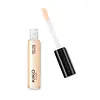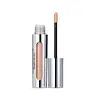What's inside
What's inside
 Key Ingredients
Key Ingredients

 Benefits
Benefits

 Concerns
Concerns

 Ingredients Side-by-side
Ingredients Side-by-side

Water
Skin ConditioningDimethicone
EmollientTalc
AbrasivePhenyl Trimethicone
Skin ConditioningCetyl PEG/PPG-10/1 Dimethicone
EmulsifyingIsododecane
EmollientGlycerin
HumectantHdi/Trimethylol Hexyllactone Crosspolymer
Phenoxyethanol
PreservativeAcrylates/Dimethicone Copolymer
Skin ConditioningSodium Chloride
MaskingHydrogen Dimethicone
Magnesium Sulfate
Dimethicone/Vinyl Dimethicone Crosspolymer
Skin ConditioningSodium Dehydroacetate
PreservativeAluminum Hydroxide
EmollientDisteardimonium Hectorite
StabilisingBenzoic Acid
MaskingTetrasodium EDTA
Dehydroacetic Acid
PreservativePropylene Carbonate
SolventSilica
AbrasiveEthylhexylglycerin
Skin ConditioningHelianthus Annuus Seed Oil
EmollientMethicone
EmollientVitex Agnus Castus Extract
AstringentCI 77891
Cosmetic ColorantCI 77492
Cosmetic ColorantCI 77007
Cosmetic ColorantCI 77288
Cosmetic ColorantWater, Dimethicone, Talc, Phenyl Trimethicone, Cetyl PEG/PPG-10/1 Dimethicone, Isododecane, Glycerin, Hdi/Trimethylol Hexyllactone Crosspolymer, Phenoxyethanol, Acrylates/Dimethicone Copolymer, Sodium Chloride, Hydrogen Dimethicone, Magnesium Sulfate, Dimethicone/Vinyl Dimethicone Crosspolymer, Sodium Dehydroacetate, Aluminum Hydroxide, Disteardimonium Hectorite, Benzoic Acid, Tetrasodium EDTA, Dehydroacetic Acid, Propylene Carbonate, Silica, Ethylhexylglycerin, Helianthus Annuus Seed Oil, Methicone, Vitex Agnus Castus Extract, CI 77891, CI 77492, CI 77007, CI 77288
Water
Skin ConditioningCyclopentasiloxane
EmollientTalc
AbrasiveCetyl PEG/PPG-10/1 Dimethicone
EmulsifyingPropylene Glycol
HumectantAcrylates/Dimethicone Copolymer
Skin ConditioningBenzyl Alcohol
PerfumingSodium Chloride
MaskingHydrogen Dimethicone
Magnesium Sulfate
Sodium Dehydroacetate
PreservativeAluminum Hydroxide
EmollientDimethicone/Vinyl Dimethicone Crosspolymer
Skin ConditioningDisteardimonium Hectorite
StabilisingPotassium Sorbate
PreservativeDehydroacetic Acid
PreservativePropylene Carbonate
SolventBHT
AntioxidantTetrasodium EDTA
CI 77891
Cosmetic ColorantCI 77492
Cosmetic ColorantCI 77491
Cosmetic ColorantCI 77499
Cosmetic ColorantWater, Cyclopentasiloxane, Talc, Cetyl PEG/PPG-10/1 Dimethicone, Propylene Glycol, Acrylates/Dimethicone Copolymer, Benzyl Alcohol, Sodium Chloride, Hydrogen Dimethicone, Magnesium Sulfate, Sodium Dehydroacetate, Aluminum Hydroxide, Dimethicone/Vinyl Dimethicone Crosspolymer, Disteardimonium Hectorite, Potassium Sorbate, Dehydroacetic Acid, Propylene Carbonate, BHT, Tetrasodium EDTA, CI 77891, CI 77492, CI 77491, CI 77499
Ingredients Explained
These ingredients are found in both products.
Ingredients higher up in an ingredient list are typically present in a larger amount.
This polymer has film-forming properties and helps leave behind a soft film on the skin with oxygen permeability.
That's why you'll most likely find this in sunscreen formulations.
Aluminum Hydroxide is a form of aluminum. It can be naturally found in nature as the mineral gibbsite. In cosmetics, Aluminum Hydroxide is used as a colorant, pH adjuster, and absorbent.
As a colorant, Aluminum Hydroxide may add opacity, or reduce the transparency. Aluminum hydroxide is contains both basic and acidic properties.
According to manufacturers, this ingredient is an emollient and humectant. This means it helps hydrate the skin.
In medicine, this ingredient is used to help relieve heartburn and help heal ulcers.
There is currently no credible scientific evidence linking aluminum hydroxide in cosmetics to increased cancer risk.
Major health organizations allow the use of aluminum hydroxide in personal care products and have not flagged it as a carcinogenic risk at typical usage levels.
Learn more about Aluminum HydroxideThis ingredient is a high molecular weight silicone. It has emulsifying and skin conditioning properties.
Ci 77492 is also hydrated iron III oxide. It's sole purpose is to give a yellow hue to products.
Iron III oxides are classified as inorganic chemicals for coloring.
Synthetically created Ci 77492 is considered safer than those naturally found. This is because the synthetically created version may contain less impurities. Iron oxides are generally non-toxic and non-allergenic.
Learn more about CI 77492Ci 77891 is a white pigment from Titanium dioxide. It is naturally found in minerals such as rutile and ilmenite.
It's main function is to add a white color to cosmetics. It can also be mixed with other colors to create different shades.
Ci 77891 is commonly found in sunscreens due to its ability to block UV rays.
Learn more about CI 77891Dehydroacetic Acid is fungicide and bactericide. It is used as a preservative in cosmetics. Preservatives help elongate the shelf life of a product.
Dehydroacetic Acid is not soluble in water.
This ingredient is a silicone used to improve the texture of products and absorb oil. It does not get absorbed into the skin.
Like other silicones, Dimethicone/Vinyl Dimethicone Crosspolymer helps condition the skin by creating a barrier. In this sense, it can act as an emollient and trap moisture in.
This ingredient is a type of elastomer.
Learn more about Dimethicone/Vinyl Dimethicone CrosspolymerDisteardimonium Hectorite comes from the clay mineral named hectorite. It is used to add thickness to a product.
It can also help stabilize a product by helping to disperse other ingredients.
Hectorite is a rare, white clay mineral.
Learn more about Disteardimonium HectoriteHydrogen Dimethicone is a type of silicone.
Magnesium Sulfate is a salt. More specifically, it is an epsom salt, or the bath salt used to help relieve muscle aches.
Despite having ‘sulfate’ in the name, it isn’t a surfactant or cleansing agent like sodium lauryl sulfate. Unlike those sulfates, magnesium sulfate doesn’t have the same cleansing or foaming properties (it's simply a type of salt).
In cosmetics, Magnesium Sulfate is used to thicken a product or help dilute other solids. It is a non-reactive and non-irritating ingredient.
One study shows magnesium deficiency may lead to inflammation of the skin. Applying magnesium topically may help reduce inflammation.
You can find this ingredient in sea water or mineral deposits.
Learn more about Magnesium SulfateThis ingredient is a solvent. It helps dissolve active ingredients and alter the texture of products.
Propylene Carbonate is commonly used in makeup and with clay, such as montmorillonite or bentonite.
Studies show this ingredient to be safe for cosmetics. When it is undiluted, it can cause skin irritation. (It is always diluted in skincare and makeup). This ingredient is water-soluble.
Propylene Carbonate is created from propylene glycol and carbonic acid.
Learn more about Propylene CarbonateChances are, you eat sodium chloride every day. Sodium Chloride is also known as table salt.
This ingredient has many purposes in skincare: thickener, emulsifier, and exfoliator.
You'll most likely find this ingredient in cleansers where it is used to create a gel-like texture. As an emulsifier, it also prevents ingredients from separating.
There is much debate on whether this ingredient is comedogenic. The short answer - comedogenic ratings don't tell the whole story. Learn more about comegodenic ratings here.
The concensus about this ingredient causing acne seems to be divided. Research is needed to understand if this ingredient does cause acne.
Scrubs may use salt as the primary exfoliating ingredient.
Learn more about Sodium ChlorideThis ingredient is a preservative with antimicrobial properties. It is the sodium salt of dehydroacetic acid.
It is especially effective at preventing bacterial and fungal growth in low concentrations.
Talc is a clay mineral. It helps absorb moisture and improve the texture of products. Like other types of clay, Talc can have a slight exfoliating effect on skin. Talc can be added to increase the volume of products.
Some Baby powders are made by combining talc with corn starch. The word "talc" comes from Latin and originates from Arabic. Talc is a mineral commonly found throughout the world.
If you have any concerns about using talc, we recommend checking out the FDA's official page.
Learn more about TalcTetrasodium EDTA is the salt formed from neutralizing ethylenediamine tetraacetic acid with sodium hydroxide. It is a chelating agent and used to prevent metal ions from binding to other ingredients. This helps keep the product and ingredients stable.
Tetrasodium EDTA comes as a white solid and is soluble in water.
Water. It's the most common cosmetic ingredient of all. You'll usually see it at the top of ingredient lists, meaning that it makes up the largest part of the product.
So why is it so popular? Water most often acts as a solvent - this means that it helps dissolve other ingredients into the formulation.
You'll also recognize water as that liquid we all need to stay alive. If you see this, drink a glass of water. Stay hydrated!
Learn more about Water